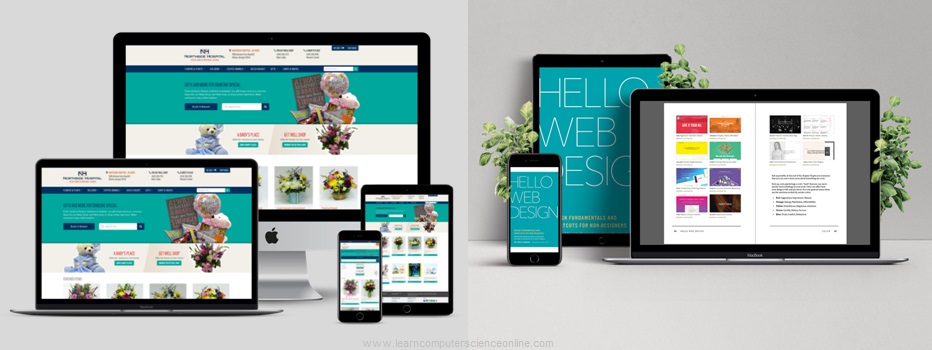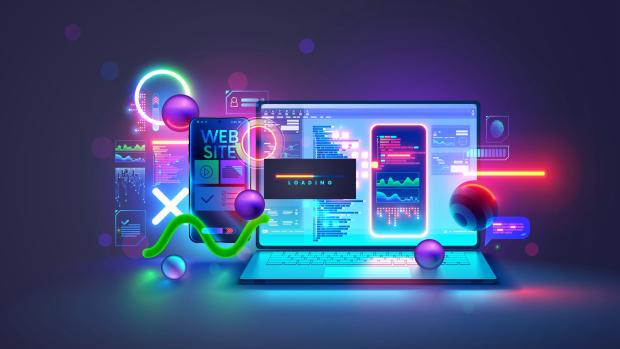Discovering the Various Kinds of Web Style and Their Distinct Benefits
The landscape of Web style includes a selection of styles, each offering distinctive benefits that deal with different customer needs. Minimalist and level designs highlight clearness, while responsive and material styles improve convenience throughout gadgets. Typography-driven and illustratory methods intend to increase engagement and emotional vibration. Comprehending these diverse kinds can substantially impact customer experience and brand name understanding. What lies beneath the surface area of these layout options?
Minimalist Web Style

Minimal website design typically includes a limited shade combination and simple typography, which not just enhances aesthetics but likewise reinforces brand name identity. The lowered complexity can bring about quicker packing times, even more improving user complete satisfaction. Additionally, by lessening visual clutter, users can involve with content more properly, leading to enhanced comprehension and retention. Overall, minimalist Web design promotes a smooth user experience, making it a preferred choice for brand names aiming to communicate quality and expertise in their online existence.
Responsive Web Style
Responsive website design has come to be important in today's electronic landscape, making certain mobile compatibility for users throughout various gadgets. This technique considerably improves customer experience by offering seamless navigation and availability, despite display dimension. As even more individuals access the Web on tablets and mobile phones, the relevance of responsive design remains to grow.

Mobile Compatibility Relevance
As smart phone use remains to climb, making certain web sites work with numerous display dimensions has come to be crucial for effective communication and interaction. Mobile compatibility, usually achieved through responsive website design, allows sites to adjust perfectly to smartphones, tablets, and other gadgets. This flexibility not just gets to a more comprehensive target market however additionally enhances brand reliability. An internet site that operates well on mobile phones mirrors professionalism and reliability and attention to user demands. Additionally, search engines prioritize mobile-friendly sites in their positions, making compatibility a critical aspect for on the internet exposure. By purchasing mobile compatibility, businesses can enhance their digital existence and cater to the expanding variety of individuals who access information on the go. Consequently, focusing on mobile-responsive style is essential in today's digital landscape.
Improved User Experience

Apartment Design
Flat style is a minimal strategy to Web style that stresses simpleness and clarity. By getting rid of three-dimensional aspects such as appearances, gradients, and shadows, level layout creates an aesthetically enticing interface that prioritizes web content and performance. This style advertises an intuitive navigation experience, as individuals can promptly determine essential features and actions without diversion.
One of the primary benefits of flat style is its responsiveness across different devices and screen dimensions. Its straightforward layouts and tidy lines adjust perfectly, guaranteeing a consistent experience for customers on mobile, tablet, or desktop computer systems. In addition, level design usually integrates bold colors and typography, improving aesthetic impact and brand name recognition.
Additionally, the simplicity intrinsic in flat design results in much faster filling times, which contributes positively to customer satisfaction - web design. Generally, level design remains a prominent selection for modern Web development, straightening with contemporary visual choices while delivering outstanding functionality
Product Design
Product Design stands for a layout language established by Google that concentrates on producing a instinctive and cohesive customer experience across digital systems. This strategy emphasizes making use of grid-based formats, receptive animations, and depth results such as illumination and darkness, which aid to produce a sense of power structure and spatial partnerships. By simulating the real world, Material Design permits customers to engage with electronic user interfaces in an extra all-natural and appealing manner.
One of the key advantages of Product Design is its flexibility throughout various tools and display dimensions, making sure a regular experience for customers. Furthermore, it advertises a clear visual language that improves functionality, making it much easier for individuals to navigate complicated applications. The incorporation of lively shades and vibrant typography additionally plays an important duty in attracting attention to vital elements, consequently boosting total individual interaction - web development. As A Result, Material Layout has ended up being a prominent choice amongst programmers looking for to create practical and aesthetically enticing web sites
Typography-Driven Design
Typography-Driven Design concentrates on the calculated use type to improve the aesthetic and functional elements of an internet site. This layout technique prioritizes typefaces, font dimensions, spacing, and hierarchy to create visual interest and overview customer experience. By carefully selecting typography, developers can share brand identity and stimulate feelings, making the content much more accessible and appealing.
Effective typography boosts readability Home Page and usability, making certain that customers can conveniently browse the website and take in information. The right mix of kind can additionally develop a clear visual power structure, allowing individuals to quickly determine vital messages and calls to activity.
In addition, a typography-driven method can be adjusted to various devices, guaranteeing consistency throughout platforms. This versatility is vital in today's multi-device landscape, where customer experience is paramount. Eventually, Typography-Driven Design offers not only as a creative selection however likewise as a practical component that significantly affects a website's performance.
Illustratory Web Layout
Illustratory Web style employs visual storytelling strategies that can significantly improve customer interaction. By integrating special pictures, internet sites can produce a memorable brand identity that resonates with their audience. This method not just captivates visitors yet additionally connects messages in a visually engaging fashion.
Visual Storytelling Methods
A wide variety of Web designers utilize aesthetic narration strategies to create immersive and appealing individual experiences. This technique incorporates layout, typography, and images to tell a story that reverberates with individuals on an emotional degree. By incorporating compelling visuals, developers can effectively share messages and evoke sensations, assisting site visitors with a brand name's journey. Infographics, animations, and interactive components offer to boost stories, making complex information a lot more remarkable and obtainable. In addition, visual storytelling can develop a natural brand name identity, as regular imagery and styles strengthen core values and messages. Inevitably, this strategy not only astounds individuals however likewise cultivates a much deeper link with the material, urging expedition and retention. Via knowledgeable application, visual narration transforms common Web experiences into meaningful and vibrant interactions.
Enhancing User Interaction
Reliable Web style greatly improves individual interaction by leveraging illustrative components that draw attention and foster interaction. Illustrations can simplify complicated principles, making them extra memorable and friendly for customers. They break the monotony of text-heavy web pages, developing aesthetic breaks that invite expedition. Additionally, distinct pictures can evoke emotions, motivating users to get in touch with the web content on a deeper degree. Interactive elements, such as animations or float results, can also enhance engagement by inviting customers to participate actively rather than passively consuming information. This strategy not just maintains site visitors on the site longer yet additionally increases the likelihood of return brows through. Eventually, effective illustratory Web style transforms the customer experience, making it a lot more impactful and satisfying.
Branding Via Illustration
Visual components play a substantial role fit a brand's identity, and images are a powerful device in this regard. Illustrative Web style allows brands to convey their special character and values via look at here custom art work. This strategy cultivates a deeper emotional link with the target market, improving memorability and engagement. By integrating images, brand names can differentiate themselves in a crowded industry, producing an unique aesthetic narrative that websites reverberates with their target group. In addition, illustrations can streamline complex principles and make content more obtainable, effectively interacting messages in an appealing fashion. Generally, branding via picture not just enhances the individual experience however additionally strengthens brand name recognition, making it a beneficial approach for services intending to develop a strong on the internet visibility.
Frequently Asked Concerns
Exactly how Do I Choose the Right Website Design Kind for My Business?
To select the appropriate website design kind for an organization, one must assess goals, target market, and sector criteria. Reviewing user experience and functionality will certainly direct the choice procedure for optimal engagement and efficiency.
What Equipment Are Best for Producing Different Web Style Styles?
Popular devices for developing varied website design styles include Adobe XD, Figma, Lay Out, and WordPress. Each deals special functions tailored to various layout needs, allowing designers to develop aesthetically enticing and useful internet sites efficiently.
Just How Much Does Expert Web Layout Usually Price?
Expert website design generally sets you back between $2,000 and $10,000, depending upon intricacy, attributes, and designer know-how. Customized options and ongoing upkeep might increase costs, while templates can use even more affordable choices for less complex projects.
Can I Integrate Numerous Web Design Enters Effectively?
Yes, incorporating numerous website design types can be reliable. By integrating aspects from various designs, developers can develop unique, engaging individual experiences that accommodate varied target markets while improving capability and aesthetic allure.
Just How Do Design Trends Influence User Experience and Involvement?
Layout patterns substantially influence user experience and involvement by improving aesthetic allure, enhancing navigating, and cultivating psychological connections - branding. Staying upgraded with fads allows developers to create user-friendly user interfaces that reverberate with individuals and encourage prolonged communications
Minimal and flat layouts emphasize quality, while responsive and worldly layouts improve adaptability throughout tools. It may appear counterintuitive, minimal Web layout emphasizes simpleness to enhance customer experience. Responsive Web design plays a necessary function in improving customer experience by ensuring that an internet site adjusts seamlessly to numerous display sizes and devices. Level design is a minimalist approach to Web design that emphasizes simplicity and quality. Material Design stands for a design language developed by Google that concentrates on producing a user-friendly and cohesive individual experience across digital systems.